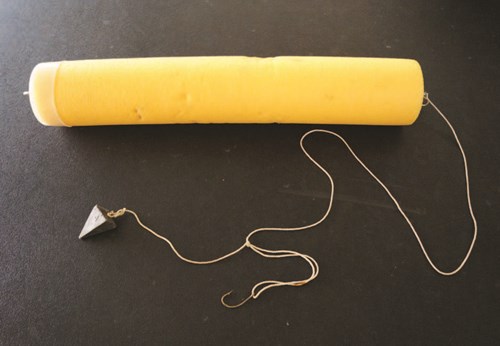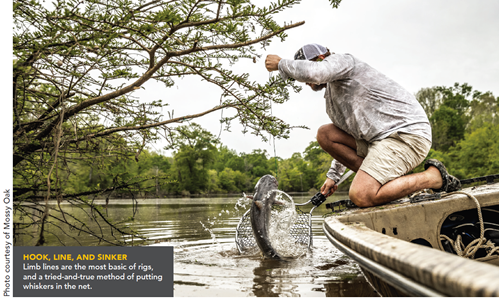8/10/2020 12:35:56 PM
By Jerry Brown

People have used several techniques to catch fish throughout history. It seems like the majority of today’s anglers follow the latest trends with fancy electronics, high-end rod-and-reels, and bass boats with 200-plus-horse-powered motors. Watch an episode of Bass Masters or Crappie Masters sometime and you will understand.
For those who might want to slow down and get back to the basics, there are alternative methods that still work and are something the entire family can enjoy.
FFFDs
Free-floating fishing devices (FFFDs), or “jugs” to most of us, are an effective and fun way to catch fish. It is also a great way to get the kids interested in the outdoors.
Capt. Scottie Jones, a Mississippi Department of Wildlife, Fisheries, and Parks (MDWFP) Conservation Officer and avid outdoorsman from Yazoo County, enjoys taking his kids on the water and introducing them to the not-so-typical ways of fishing.
“With jug fishing, there’s always something going on and never a dull moment,” said Jones. “It’s a great family event that gets everyone involved from baiting hooks, watching the jugs for movement — or even going under like a cork — and the kids can take turns retrieving and netting fish.”
Jones said that catfish are generally the targeted fish when using FFFDs, but other types of fish can be caught too. “I know individuals who have targeted gar,” Jones said. “The exciting thing about jug fishing is that you really never know what you might catch.”
FFFDs can be made from almost any type of empty container that floats, such as milk jugs and 2-liter soda bottles. In recent years, it has become popular to make them using a piece of PVC pipe and a section from one of those colorful pool noodles that kids use while swimming. It is quite easy to spot your FFFD floating down a stream when it is a bright green, pink, or blue.
Making an FFFD is simple. Cut a piece of heavy fishing line to whatever length you want to fish and attach to the FFFD. Add a weight and hook to the other end of the line. That is all there is to it.

“Basically, anything can be used for bait,” Jones said. “Blue and channel catfish are scavengers, so anything like a simple hot dog can be cut for bait. My favorite baits are hot dogs, shad, liver, etc.” Live bait, such as crawfish or bream, is preferred when fishing for flathead catfish.
“Jugs can be fished in any water body. However, water that has some current to it will make your chances of catching fish a lot more productive,” Jones said. “You cover more water when your jugs are moving. I also like to fish jugs in the spring and summer. Typically, fish are moving and coming up to feed. The weather is more favorable than for a family event, too.”
Going jug fishing can be a low-key, relaxing way to fish because you simply bait them up, toss them out, and float along in a boat waiting for a bite. Once a fish is hooked, your FFFD will act like a cork bobbing up and down, or moving faster than the others, as the fish swims. With the new pool noodles, the device lays flat on the water’s surface and quickly stands up when a fish pulls the line. It gets exciting when multiple catfish are on at the same time, and kids will have a blast chasing them down.
Limb lines
Limb lines can also be a fun way to catch catfish. This simple approach has been used for many years. According to Jones, limb lines are a lot like jug fishing because they can get the whole family involved. “I love using kids as spotters,” Jones said. “There’s nothing better than watching a limb move up and down from the force of a fish trying to get away, and the spotters screaming, ‘Fish on!’”
Rigging a limb line is relatively easy, too. The angler ties a fishing line to an overhanging tree limb along a river or in a lake. A hook and weight are added to the end of the line, and some anglers like to add a swivel to minimize twists. Deep edges along a stream bank are good places to fish limb lines for catfish. Limb lines can be used any time of the year and can be extremely productive.

“The exciting thing about limb lines, you never know what size catfish you might catch. The size will greatly depend on your hook size and what bait is used,” said Jones. He also mentioned that bait choices are the same as with jug fishing depending on which species of catfish you are seeking.
“I even know individuals who used cut up bars of soap for bait.”
As for beginners, Jones advised, “It’s a relatively inexpensive way to catch fish. Research places you choose to fish, then sample with different baits until you find one that works, and then go fishing.”
You can find lakes, reservoirs, and streams of all sizes across Mississippi, and catfish are plentiful in almost all of them. FFFDs and limb lines are not allowed on some water bodies, such as MDWFP State Fishing Lakes and State Park Lakes. Be sure to check out the fishing regulations for a particular water-body before planning your trip.
Jerry Brown is the State Lake Coordinator for MDWFP.









